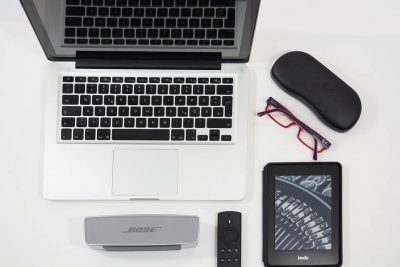
Remote work is all the rage these days.
As it turns out, one of the reasons why people love working for Goldman Sachs is because they allow top performing employees to work remotely.
In fact, there are people here, in this world, who have lived out of nothing but a van for years on end.
And there is nothing wrong with that.
Everybody needs a bit of “fresh air” from time to time.
You could be taking a long trip away from your home or just trying out something new.
The modern world demands that we work.
Table of Contents
And that we work from any place we find ourselves in.
Technology now has made it possible for everyone to work from anywhere and everywhere.
With that said, working from anywhere isn’t as simple as leaving your office or your home and start working.
You have to make sure that you have the right gear in order to handle all your work.
In fact, we think proper gear can make that critical difference between a user finishing work via a smooth and effective remote working session and a working session that one would describe as a complete disaster.
This guide will show you the key kit that will help you get your work done from anyplace in the world.
Make sure you pack your bag with the right gear before heading out on the road.
We won’t include some of the obvious items such as a laptop and other computer peripherals like a mouse (depends on preferences).
This Remote Work guide will follow a certain pattern.
That pattern will involve different sections for different items.
As far as individual sections go, we have tried to point out some purchases that people should give some consideration to.
But these suggestions are just for ideas.
This guide isn’t about being the most comprehensive buyer’s online guide on the planet.
If readers make a bit of effort on their own and shop around then there is a great possibility that they might be able to find something that fulfills their need better than our suggestion.
So keep that in mind while reading the rest of this post.
Remote Work: Take Care Of Your Power Needs
When you want to work away from home, you need to make sure you have enough power.
Buying the most long lasting laptop in the market isn’t going to help much here.
Why?
Because even the ones that have the longest-lasting batteries don’t stand a chance of giving you much after you end your hectic working day.
In other words, they will struggle.
And hence you need some extra juice in order to make sure that your laptop doesn’t die on you at the most inconvenient of times.
The other reason you have to do everything you can to prolong the lifespan of your laptop’s battery is that you can’t risk your work.
When you are out on your own trying to work, two things usually happen.
Either you submit your work right on time.
Or you don’t.
And hence fall behind schedule.
If you want to increase your chances of completing your work then extra power is a must.
To solve your problem of a long battery life, you could carry around multiple power bricks.
Some of these do come with enough power juice that they can recharge your laptop.
But they are heavy.
And you need to be light while traveling or working away from home or from office.
Moreover, power bricks aren’t the cheapest piece of equipment that you can buy either.
Remote Work: But are they worth the investment?
Yes.
They are.
Even if they increase the strain on your back, they are still worth it.
Okay, so what about our recommendations?
We recommend that you make use of Mophie Powerstation USB-C XXL which costs around $150.
But do take note that this power bank works best for new laptops which come with USB-C charging ports.
Nevertheless, it does give users dual charging ports.
Additionally, it has a 19,500 mAh capacity.
As mentioned before, it is a bit expensive.
So you might want to go with the much cheaper option which comes in the form of Anker PowerCore+ 20100.
The Anker PowerCore+ 20100 also provides USB-C charging compatibility.
Even though it is cheaper than the Mophie Powerstation USB-C XXL, it still has the slightly bigger battery capacity of 20,100 mAh.
No matter which machine you are working on, that is quite an amount of juice.
Perhaps this is a good time to mention one other important thing.
While buying these external battery packs, you have to take into consideration the fact if the battery pack you are buying supports laptop charging.

Most of these battery power banks only support charging of devices such as,
- Ereader
- Tablet
- Phone
- Some random console gaming sessions on Nintendo Switch
Remote Work: Moreover, you also need to know your laptop’s watt requirement.
The majority of USB-C type charged laptops do work with battery power banks that we have mentioned above.
But some laptops require even more power.
After All, laptops are power-hungry machines.
Hence, in order to confirm the best battery that will work with your laptop, you must find out first the number of watts that your laptop would require.
For example, a MacBook can work perfectly well with 40 W.
Not MacBook Pro though.
It requires around 60W.
So how do you find out how much power your laptop requires?
Well, this is where you will have to do a bit of learning.
Mainly by reading the requirements of the laptop that you are using via its manual.
You can also check for your laptop’s specifications on various online forums and websites.
The information is out there.
You just need to find it.
There is one other method with which you can skip everything we said above in the last couple or more sentences.
You can just go ahead and look at your laptop’s current power supply.
Yeah.
That one which you are using with your laptop right now.
If you are able to read the watt requirement off the power supply, you’ll save yourself even more time.
So what to do after you have learned and determined your laptop’s watt requirement?
Well, now is the time to get moving and select an appropriate battery for your laptop.
Battery manufacturers naturally do not list the output of their battery products in watts.
They find more happiness in listing those statistics in amps and volts.
To get the watt requirement, just multiply volts with amps.
And you’ll get your power requirement.
So let’s say that you have two batteries.
Each one says 4 amps and 12 volts.
In such a case, each one would produce around 48 W of output.
Some of us have laptops which require even more juice.
If you have such a laptop then perhaps the Maxoak 50,000 mAh battery would do the job for you.
It will cost you around $136 though.
For more power consuming laptops, that is a price that you might find appropriate to pay.
The Maxoak 50000 mAh battery is a 3A/20V battery.
This means the Maxoak battery would work on a laptop that eats up 60 watts as its requirement.
These are power-hungry laptops.
But again, they provide performance as well for all that juice.
Remote Work: You Need to Find A Connection When outside
So what should be your first port of call if you want to get online away from home and office?
Well, if we are talking about on-the-go connectivity then your smartphone is your best option.
Of course, you are going to have to make sure that you actually have a subscription plan that enables you to use features such as tethering.
The other thing you need to ensure here is if your carrier won’t cost you your savings for using features such as tethering.
In other words, most carriers charge astronomical rates when users want internet connectivity on the go.
You need to subscribe to the right packages in order to get cheap internet on the go.
The best place to start in this case it to check your most current subscription plan.
That will give you all the details that you need.
Of course, there are always public Wi-Fi connections in hotels and coffee shops.
But these options have a problem.
They aren’t that safe.
In fact, they are unsafe.
Our suggestion for getting internet connectivity on the go changes when we are talking about someone packing up some gear in a bag.
For such cases, we recommend that users should go with a dedicated and solid mobile hotspot device.
What are these mobile hotspot devices?
These are just gadgets.
They work in a similar way to tethered smartphones.
But they have one advantage over smartphone devices.
They are custom built for a single and specific job.
Hence they offer most robustness.
Users also find them easier to operate and work with.
Moreover, mobile hotspot devices also allow you to save your smartphone’s battery life.
All the while you can still use the internet via the device.
So which mobile hotspot devices should you purchase?
Our recommendation, in this case, is ZTE Falcon Z-917.
It will cost you around $45.
The concerning thing about ZTE Falcon Z-917 is that it supports T-Mobile networks.
Hence, users who want to make use of this device for internet connectivity will require a data plan to use with it.
At the same device, the good thing about this device is that it can provide internet connectivity via mobile hotspot for a total of 10 devices at the max.
Remote Work: There is also the Jetpack MiFi 7730L.
Verizon is the company that sells these.
It has one advantage over ZTE Falcon Z-917 in that it supports up to 15 devices simultaneously.
Users can purchase this MiFi device for just $49.99.
Most of all, it comes with a two-year internet data plan as well.
Users who want to charge their smartphone devices can do so with the Verizon mobile hotspot device.
Remote Work: Let’s Talk About Data And Hoarding

Let’s clear one thing up:
The days of people considering external hard drives are well and truly over.
They aren’t essential by any means now.
But just because something isn’t essential, doesn’t mean you don’t need it.
Besides, there was a time when people did consider external hard drives as essential.
Then cloud storage came along.
And everybody started to upload their stuff directly to the cloud.
When you are talking about remote work, external hard drives can still come in real handy.
There are many reasons why we say that.
The first and probably foremost reason is that with an external hard drive, users can simply dump all their data from their home computer onto the hard drive.
Then they can take that external hard drive to any place they want to.
Of course, there is also the chance that you already have all your data on your laptop.
If that is the case then great.
Because don’t think you’ll have internet connection everywhere you go once you hit the road.
Most people, while they are traveling, actually struggle to get a consistent Wi-Fi connection.
Then there is the fact that it is always easier to get your data from an external hard drive rather than the cloud.
Loading and then searching for stuff via Dropbox using nothing but a web browser can become a painfully slow experience when you are out in the real world.
On top of that, people also need space when they want to back up their new files.
Remote Work: You are going outside to work right?
That means you will probably create some files.
Might take some photos as well.
Since you aren’t close to your home base, you need to have an external hard disk nearby to save everything.
We know we have mentioned at the top that external hard drives aren’t essential anymore.
But even if you buy one today you can’t really go wrong.
The market offers a ton of variety.
And all models suit specific types of users.
Moreover, there are many reputable names in the external hard disk drive business.
One thought though:
It is always better to go with more storage than what you think you’ll need in the future.
The funny thing about external hard drives is that they fill up real quick.
And before you know it, you don’t have any space left.
Users who want speed and reliability may want to go with WD My Passport SSD.
It will cost you around $99.99 if not more if you buy the one with the maximum capacity of 256GB.
But the thing about WD My Passport SSD is that it is great at its job.
And since it is an SSD external drive, it is ultra-fast.
Expect it to reach speeds that you never thought were possible with an external drive.
Users who want a bit more space while they are tight on a budget may want to go with Seagate Duet.
It costs users around $99.99, the same as WD My Passport SSD.
But it offers more capacity as it comes in 1TB edition.
The Seagate Duet is a rather decent external hard drive option for anyone who is an Amazon fan.
Why do we say that?
We say that because the Seagate Duet automatically manages to sync with the very good Amazon Drive.
Remote Work: Power And Adapting To It.
People who are committed to going all-in in their quest to have a remote working lifestyle have to take care of lots of things.
And because of the fact that they take care of so many things, they are able to do their job abroad with ease.
But the thing about working abroad is that once you set yourself up, plenty of new challenges, or rather a set of them, constantly raise their ugly heads.
And irritate users.
One of the irritating problems that remote workers usually come against is a foreign power connection.
If you haven’t prepared for it, you can forget about recharging any of the many gadgets that you are carrying with you.
Remote workers who live in nice hotels, may have the option of requesting the hotel management for power adaptors which they can use.
But it doesn’t work out everytime.
Besides, your work is important.
You can’t risk it to some hotel management people.
In other words, it always pays if you prepare and bring in your own power adaptors.
For those who live to prepare, they might even find some usefulness in a small power strip in their working backpack.
Before you go ahead and make arrangements for a separate power strip for your remote work, make sure it fits in your backpack.
With a power strip in hand, you should have no problems in charging up any number of devices from a single adapter and socket.
Just ensure that you are not overloading your powerstrip.
Of course, that isn’t really an issue for users who are only dealing with portable gadgets.
Remote Work: So what about buying options here?
Well, there are a host of purchases you can make right now as far as power adapters are concerned.
Hence, you’ll need to take your time.
And then pick a well-reviewed and solid power adapter.
Maybe go for two if you feel like it.
As far as the best adaptors go, we like the Iron-M Universal Travel Adapter which costs $16.58.
You can also go with Foval International Power Travel Adapter which will set you back around $37.98.
These adapters are great because they have the capacity to work with several types of power outlets or sockets.
Moreover, they also come with USB ports.
On top of that, these power adapters also come with a mains connection.
Remote Work: Audio And Things That Block Sound
The outside world is going to through a lot of clamor at you.
If you want to make sure that you shut that off then the best option is to go with over-ear headphones.
Some like to use in-ear earbuds for that purpose.
And that’s fine as well.
The thing to take note of here is that for focusing on your task while you work remotely you need to shut off from the environment.
And then try to get things done.
Maybe you have already finished your work and now want to relax by listening to some good audio track or something.
Modern options also include soothing background noise or audio track which can help you calm down or even sleep and meditate.
Pumping out your favorite audio track at a coffee shop or in a library isn’t an ideal option no matter which country you are in.
Hence, get one good pair.
It is preferable that you get one which has a built-in mic as well.
Most of the times, manufacturers place the mic somewhere near the cans.
Some ship them somewhere in the cable.

No matter which one you buy, once you have a set you’ll have everything you need to launch chat videos with all of your co-workers and/or boss.
Remote video conferencing call?
Not a problem.
There is nothing you can’t cover if you have the right equipment.
Ensuring that you have the right gear to make your clients happy will go a long way in your own self-worth and getting satisfaction from your work.
Don’t forget.
With an internet connection and in-ear earbuds, you can chat with anyone in the world.
So don’t skip on catching up with friends/family and others.
Remote Work: What about wireless headsets though?
Well, again it depends on the person’s preferences.
If you just can’t stand wires, then, by all means, go for a wireless headset.
What about the budget then?
You don’t really need to spend big in this department if you don’t care about having the best audio fidelity.
A nice pair of in-ear buds won’t cost you much at all.
However, for those who just want to spend and spend hard to get the best experience, there is always a good option.
For wireless fans, the best option today is AirPods from Apple.
These iconic in-ear earbuds will cost you around $159.
They come with a decent integrated microphone.
More importantly, for some, they can easily pair with Windows and Mac laptops.
Remote Work: What about iPhones?
Well, these can pair with them as well.
While we’re at it, let’s take a look at the opposite end when it comes to size scale.
There are a lot of good options in this category as well.
But when it comes to headphones, especially recent ones, our research shows that Sony WH-1000XM2 headphones are impressive.
They will cost you around $348 though.
Now that we have set you up on your journey to achieving freedom in the way you work, you also need to know how to keep other people away from snooping on your smartphone device and/or laptop.
Remote Work: How To Guard Your Privacy
Most people who would try to look in places where they shouldn’t be looking will come under the category or “Friends”, or “Family”.
Sometimes strangers can also do that.
But by the time your stranger has looked at your data physically, your machine is well and truly gone.
That is, stolen.
And then probably shredded.
More and more people are getting security savvy with each passing day.
Perhaps all of these people have a reason to do so.
We don’t blame them.
Smartphones aren’t just devices with which you make calls and receive messages anymore.
These devices have become a part of the human body.
They contain sensitive information.
And one could do worse than protect his/her smartphone with good security practices.
The same goes for laptop machines as well.
While most guides tend to focus on how to protect your laptop from strangers, we would like to focus on another group.
That group is F&F.
Remote Work: Friends and Family Threats.
Most users don’t protect their smartphones and laptops against the people who live in their home.
Particularly we’re talking about people who are worried about protecting their data from,
- Horrible siblings
- Clumsy kids
- Nosey housemates
To make sure that your private stuff remains that way, here are some steps we think you should take immediately.
Remote Work: Lock Your Devices Up
This tip is even more important for those who want to work remotely.
Most modern laptop machines and smartphone devices come with some sort of protection.
These usually come in the form of,
- Fingerprint scan
- Face scan
- PIN pattern
- Password
For the rare cases where you don’t have any of those on your machine, you need to get something for your security in place right now.
After all, your first line of defense is that initial protection.
That initial protection prevents anyone else from passing your initial screen to your most sensitive information on your laptop.
Without a password or a pin, anyone can view data related to your files and apps.
Remote Work: As mentioned now, there are lots of options when it comes to default protection.
If you are using an Android smartphone then you should make your way to Security & Location from the Settings menu.
Then tap on the option that says Touch ID & Passcode.
Some smartphones will have Face ID & Passcode instead of Touch ID & Passcode.
Yes, we are talking about iOS devices.
For Windows users, they need to go to their Settings and then click on Accounts.
Then they need to click on Sign-in options.
MacOS users will have to go to System Preferences first.
And then click on Security & Privacy.
One other great way to secure your device against unwanted access is to dial down the time it takes your device to blank the screen.
Yes.
Those time-out settings.
You need to make them shorter.
Adjust till your device automatically locks as soon as you have stopped using it.
But, what’s the problem with a long time-out delay?
Nothing major.
Just the fact that someone could take advantage of your unlocked device if you step away from your smartphone or laptop for even a single moment.
So stop that “someone” from taking advantage, make sure your time-out setting is set to an absolute minimum.
Remote Work: Where are these options?
On the Android platform, you will need to first go to Settings.
And then to Display.
After that, you should make your way to Advanced.
And then click on Sleep.
For iOS users, they will first have to access their Settings app.
And then go to Display & Brightness.
After that go to Auto-Lock.
And that should do it.
What about users who are on the Windows platform?
Well, they need to read the next sentence.
First, you go to System.
And then to Power & Sleep.
This is where you will find the time it will take you machine to sleep after you haven’t performed an action on it.
For macOS users, they must first click on System Preferences.
And then go to Energy Saver.
Remote Work: The Best Security Is Biometric Security
Or is it?
Regardless if it is, you should definitely check it out.
The problem with living with people who know you is that they probably have a better idea of you than anyone else.
In other words, they have possibly seen you go up to your machine and enter your PIN code many times.
Perhaps hundreds of times if not more.
And because they know you so well, they can probably take a good guess at any and all passwords that you set for your machine and/or laptop.
It is entirely possible that they might already know your password.

Yeah.
Remember that one time your Friends/Family member asked you for your machine’s password because they wanted to get something done urgently?
Yeah.
That’s how they know.
The point that we want to make here is that password and PIN codes offer effective deterrents for people who want to unduly access your machine.
But these work best against complete strangers.
Not for people who know you.
Well, they do work against people who know you but they aren’t as effective.
Someone who talks to you and sees you for any reasonable chunk of time may get past your password and/or PIN rather easily.
And there are many reasons for that happening.
Maybe you’re the type of user who has written his/her password somewhere on a sticky note or something.
Or perhaps your friends/family saw you unlocking your smartphone over your shoulder.
Remote Work: There are many other such scenarios.
To make sure your smartphone is safe from prying eyes, you must make use of biometric security features.
These include new options such as face scan and fingerprint.
They are much more effective at making sure that you are the only person who can unlock your laptop and/or smartphone.
Once you have found these options on your laptop and/or smartphone, then you must use them.
So does that mean that you should get rid of your password and/or backup code?
Absolutely NOT.
Lots of laptops and smartphones still don’t give users any other options than password and/or PIN code.
If you have such machines, then you have to use the options which are available to you.
While you’re at it make sure you make your password and PIN code difficult to guess.
Remote Work: It is a good idea to change your password regularly as well.
The one thing you should never do is use your birthday year, month and/or date as your PIN code.
Trust us, it is not a good idea.
Your family members along with friends and probably your roommate as well knows your birthday.
Hence, if you have used such a PIN then your machine may not be safe once you leave it alone in the room with your roommate in it.
Readers need to remember the fact that people usually let their guard down they find themselves in places which they consider as safe.
Places such as their own home.
Or their own hostel room.
Hence you should also be aware of anyone who is around you when you are trying to log in to your machine.
Or accessing sensitive apps and sites.
Remote Work: Keep An Eye On What You Are Sharing
People who live with you for longer periods of time have another advantage over random hackers who try to hurt you remotely.
Of course, we’re making the big assumption here that they actually want to see and access your private stuff.
Okay, back to that advantage again.
The main advantage that these people have is that they are present usually on the very same WiFi private network as the one who wants to protect his/her stuff.
What does that do?
That makes it easy for them to exploit certain situations and have a go at your devices.
Hence, this tip will have you making sure that you are actually not sharing anything with anyone more than you would like to.
Remote Work: Let’s start with how to do that for Windows users.

Windows users should have a look at their File Explorer and click the option that says Network.
Then it is just a simple matter of checking which folders users have shared with what remains of their private network.
For Mac OS users, they need to go to their System Preferences and then click on the option that says Sharing.
While checking for any unnecessary sharing, do keep a lookout for media servers.
Also for Chromecasts as well as anything else that might share your data with people you don’t want to share certain things with.
Hence, the thing readers need to remember here is by design, anyone else on the same private Wi-Fi network can and usually does get through to these type of devices.
That is just the way they are built.
Perhaps this is also a good time to point out that with just a tiny bit of work, anyone on the user’s private network can monitor and check any and all the traffic that is passing, at any given moment, through that private network.
When you really think about it, that someone could also potentially observe any/some or each and every website that the user is visiting.
Or has visited.
Users don’t have to worry about their information related to passwords and credit card details.
Why?
Because usually these are encrypted.
That doesn’t mean you don’t need protection against such type of snooping.
So, one of the easiest and most comprehensive ways to protect yourself against such problems is to use a VPN service provider.
VPN service providers come in real handy if you are of the opinion that someone from your own house would have the time and the energy to make unwanted advances and spy on your online activities.
Remote Work: There are lots of options here.
But we usually recommend IPVanish because it offers great speed, reliability, and uptime.
It also comes with a money-back guarantee.
And hence you don’t have to worry about wasting your money while you sign up for IPVanish.
To sign up for IPVanish right here and right now from the official website
That takes care of anyone trying to access your private information.
Along with using a VPN service, you should also make it a habit to only stick to HTTPS sites.
HTTPS sites offer a great benefit to users in the sense that the user’s connection is encrypted.
We should also mention here that the majority of the popular sites in the world of the internet have HTTPS.
It has become a standard in recent years.
Remote Work: Coming Up With Limits
You will probably frequently find yourself in situations where someone you live with comes up to you with a request.
A request to use or borrow any of your gadgets.
Understandably, you may worry about that someone seeing the stuff that you would rather not have them see.
To make sure that this does not happen to you, we need you take the below mentioned steps.
This is where if you are on macOS or Windows laptop, you’ll find much ease.
Because all you really need to do here is to set up a guest account or a separate user account that your roommate, family and/or friends can log into.
That will ensure that all of their files and apps stay separate from your apps and files.
For macOS users, they can also opt for setting up a guest account.
Windows used to have this option.
Not anymore.
Anyway, for the macOS, just go to System Preferences and then to Users & Groups.
And that is basically it.
Follow the on-screen instructions and you should be golden.
We just mentioned that Windows used to have a guest account feature.
Now it doesn’t.
But that doesn’t mean you can’t set up a guest account of your own.
It is a workaround, albeit an average one.
Basically, a user will need to set up a new account (a normal one without administrative privileges) with any name they like.
Then they can call it their new guest account.
And that’s that.
For Android users, there is one little neat trick that you can use.
This trick makes use of an Android feature which is called screen pinning.
To enable this feature first go to your Settings menu.
And then perform a tap on the option that says Security & Location.
Then you need to hit the option that says Screen pinning.
After you have tapped that option your smartphone device should turn this feature on.
Your smartphone will use a PIN lock with the screen pinning feature.
Then make your way to the Overview screen.
To do that just tap the button that comes in the shape of a square.
It is usually the navigation button.
Look at your overview screen and you should see a medium pin icon.
Tap on the icon to select the pin option.
After you have done so, your smartphone device would lock your family member or friend inside a single app.
They won’t be able to get out of that app unless they press the Overview and Back buttons and then enter the PIN code.
What does all of this mean?
It means that no matter who is using your smartphone device, they can only use the app that you want them to use.
They can access nothing from the rest of your smartphone device.
The iOS devices have a similar feature.
It is called Guided Access.
Users can find this option by first going to Settings.
And then tapping the General option.
Then going to the accessibility option.
When you have the app that you want your smartphone device to lock on screen, just triple-click your device/s Home button.
If you are using the iPhone X then you will need to tap the Power button.
This would effectively enable your smartphone device to restrict any other user to a single app.
And the only way out of that app would be to enter the user’s PIN code.
You could also use Fingerprint and/or face scan instead of a PIN code.
Remote Work: Security And Upgrades

The majority of the time, people find themselves living with other people who they consider as trustworthy.
And perhaps even loyal.
Some even get friends who they find easy to get on with.
But the operative word here is “majority”.
There are those situations where you have none of that.
And that’s okay.
In such a case, there are other options that you can take advantage of.
You’ll need a bit of extra gear though.
Even though you’ll spend something for this extra gear, you’ll at least ensure that your devices remain safe even when you are around people who you don’t trust.
A little extra gear can also go a long way in protecting your devices from wandering hands and prying eyes.
The first option is to get a starter security safe.
Yes.
And trust us, it will help a lot in the long run.
It will keep your phone and your laptop protected while you concentrate on other tasks.
If you go to Amazon and search around for a bit you can find decent models that will cost you just $60.
Remote Work: There are ways to get even more peace of mind though.
If you have the money then you can even fix your safe under your desk or in a cupboard on a permanent basis.
And while we’re on the topic of gadgets that lock down your stuff, how about laptop locks?
These don’t cost much money, to begin with and can prevent anyone from simply walking up straight into your room and then proceeding to swipe the laptop device while the user (you) are out of your dorm room, apartment or house.
The only thing you need to double-check here is if you are buying the correct cable for the correct lock type which comes pre-installed or integrated right into your laptop.
Only after ensuring that should you go ahead and pay for the lock.
Remote Work: There are other more-secure options as well.
People who are extra concerned about a person walking into their premises while they’re away somewhere might find it appropriate to invest in a security camera.
Or even a motion sensor system.
These are not as expensive as they used to be.
Neither are they now difficult to properly set up.
On the plus side, the market has a good bunch of hardware options for users to take their pick from.
Moreover, many of these hardware options allow users to set up a live feed from their smartphone devices and tune into the live feed at their own convenience.
Remote Work: Conclusion
That is it.
Now you know everything you need to know to work from anywhere without having to worry about anyone snooping on your things or getting late on your deadlines.
Do use the comments section below to let us know your thoughts and opinions.


Bad article WHY because blocking me facebook does not work and these articles still SUCK
This isn’t about unblocking Facebook.
This guide is about the gadgets you would want to use if you want to work outside your office or home.